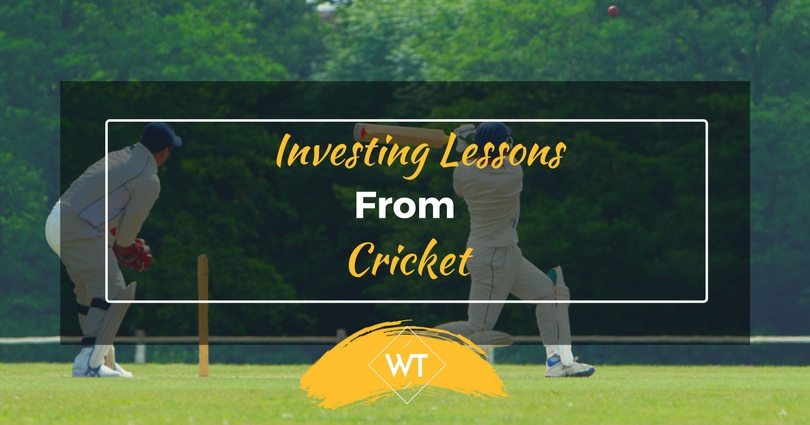Investing Lessons from Cricket

Investing lessons from cricket…confused???? Investing lessons are not the enigmas or mysteries that only financial wizards can crack. In fact many real life experiences from various disciplines can be applied to investing as well. There are many examples of professionals such as doctors, lawyers, mathematicians, engineers and others who have been successful at investing.
Some lessons can be learnt from sports, media, politics and other fields as well. Cricket is one such sport where many corporate honchos have invested in different teams. Cricket in India is a billion dollar industry. Indian Premier League (IPL) has also proved to be an excellent entertainment cum business proposition if we keep the controversies and issues aside for now.
Investing Lessons from Cricket
There are several parallels that can be drawn between cricket and investing. Although a one-to-one comparison doesn’t work, we can use some examples to understand the intricacies of investing through cricket/sports and the strategies. For instance long-term investing can be compared to test matches or marathon racing, while day-trading can be compared with the strategies used by sprinters.
Disclaimer: The examples, illustrations and comparisons between cricket and investing is only for easier understanding. Readers are requested not to take such comparisons at face value, but just take it as an story or anecdote for the purpose of understanding the basic principles of investing.
The Pitch (Economic & Global Conditions)
The pitch and weather conditions give you an indication of the overall behavior of the ball – the bounce, speed, how it comes on to the bat, etc. In some cases this becomes very important and can determine the outcome of the match itself. Examining the ground/pitch is critical for both teams because there are several matches which are won during the toss stage itself.
Having said that it does not mean that toss itself can significantly influence the match, because other factors such as good fielding, fielding placement, quality of bowling, strong partnerships, etc. can also turn the match in one’s favor.
Similarly in investment the domestic economic climate, global economic conditions, industry trends, etc. have an influence on the market as a whole. For example if inflation is high people’s spending power will come down and can affect FMCG sector and FMCG stocks such as ITC, Hindustan Unilever, etc.
However, despite this the demand for FMCG continues because these are essentials for the common man. Hence, FMCG continues to grow though at a slower rate, while other industries see a dramatic slowdown and even negative growth rates.
Investors have to choose or select stocks carefully in order to deal with the economic conditions. In cricketing terms there are dry pitches as in most parts of India (tropical hot/humid areas) which favors spin bowlers and gives them the right kind of turn or spin. In contrast pitches in Australia are more favorable for fast or pace bowlers giving them the right amount of pace, bounce and swing (lateral movement).
Some macro level factors in cricket and investing are shown in the following graphic.
Cricket
- Ground surface
- Soil Moisture
- Humidity
- Grass
- Wind
Investing
- GDP Growth
- Inflation Rate
- Interest Rate
- Currency Exchange Rate
- Index of Industrial Production
Note: The above is purely for illustration purpose only and not to be taken as a direct comparison.
Investment Horizon (Match Format)
This is quite critical in cricket as well as investments because this can influence your strategy or tactics. For instance trading requires the same mindset as in T-20 or one day matches, while investing requires a long-term thinking/approach as in test matches.
Long term investors should learn from Marathoners (long distance runners) to be patient enough to withstand volatility and sustain through different market cycles. A marathon race requires a completely different skill when compared to sprint or 100 meter races. Marathoners have to be good an enduring and sustaining their energy and power till the end of the race, while sprinters are more focused on getting a head start ASAP.
If you try to trade your investments you will not emerge as a winner in the long run because you would be booking short term gains while losing the long-term wealth building opportunity.
For instance a marathon runner should not be running as fast as a sprinter, and doing so will lead to exhaustion.
|
Cricket |
Athletics |
Investing/Trading |
|
T-20 (20 overs) |
100 m sprint |
Day trading |
|
One day match (50 overs) |
1000 m race |
Positional Trading |
| Test Match | Marathon | Investing |
In T-20 you don’t have the luxury of waiting for the good balls. You have to put score on the board even if it comes at the cost of a wicket. Similarly in trading its important to keep a close watch on profits and stop loss and close positions at the end of day or in a few days (in case of positional trading). In case of long term investing you can patiently wait for a good time to enter stocks at the right price (say reasonable price) and similarly exit on a huge price spike. A similar flexibility is available in test matches where players can go slow and steady and wait for the right opportunities to score boundaries.
Portfolio Management (The 11 member squad)
In cricket its important to have a well-balanced and diversified team with requisite skill set, which is comparable to a diversified portfolio of investments. However, in investments one has to go one step further to diversify across asset classes such as equities, debt, gold, real estate, etc.
Core Investments/Core Team
The core stocks/assets in the portfolio should be kept intact while the remaining parts can be tweaked or altered as per market conditions. These core assets are large cap stocks, gold, etc. While you can reduce exposure or book profits, its important to retain them for long term wealth and growth opportunities.
For instance the team management and selectors identify the core players for every tournament. For instance MS Dhoni, Virat Kohli, Harbajan Singh and a few others have been considered part of the core team (Of course ardent cricketing fans and experts can provide better examples here). Just like test cricket, investing requires patience while speculation is more in line with twenty-twenty format. It requires patience. ace and realistic expectations.
Strategy & Tactics
The strategy is obviously critical for investment as well as cricket. Strategy is more long term in nature where you decide on the broad plan or structure or investing principles which should remain constant overtime barring few changes. Tactics are more short term opportunities which you want to cash on. Its important to use a mix of both strategy and tactics appropriately to get the full potential out of your investments.
Final Words – Investing Lessons from Cricket
Investing lessons from cricket are aplenty and a cricket crazy nation like ours can learn a lot from this gentleman’s game. Although we drew a lot of parallels we should not get carried away, because sports or games have a different objective compared to investments.
Some of the principles applied to sports or games may not work in case of investments.
For instance in a one day match where the team has scored 300 runs in 40 overs with 5 wickets in hand, the batsmen can speculate or can take huge risks since there is nothing much to lose with 300 runs already on the board. But in investing protecting your capital or profits is also important because there is a possibility of loss as well.
So tread with caution and focus only on the best practices that work for investing, which deals with your hard-earned money. For investors the focus should be on being able to run the marathon but at the same time booking profits or gains (as hitting boundaries on the loose balls in cricket).
Since the ground conditions and environment changes one has to keep their portfolio updated to match with the current environment. This is where portfolio re-balancing and asset allocation plays a key role. If you follow some select best practices of sports in investing over long-term you too can become a large investor like the IPL franchise owners. I invite all cricket enthusiasts to share comments, examples, feedback or views on this subject.
As an intelligent investor, you should tactfully avoid making such mistakes and enjoy a bright future.









Leave a Reply